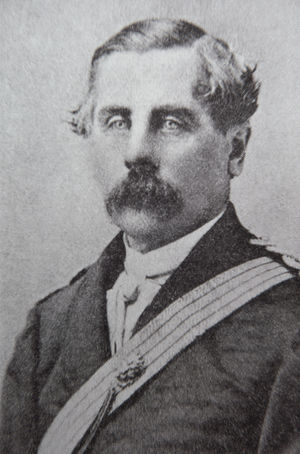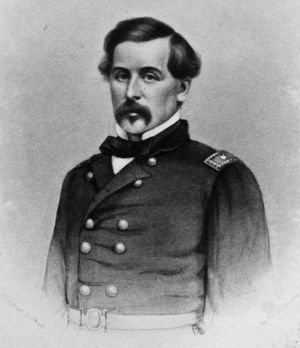How Did Thomas Francis Meagher Really Die
The life of Thomas Francis Meagher was one of honor and service. His death; however, has been shrouded with mystery and shame for the past one hundred-fifty years. On July 1, 1867, Meagher (pronounced Mar) fell from a steamship docked in Fort Benton, Montana into the Missouri river and was never seen again. Theories have been argued as to whether Meagher committed suicide, had a tragic accident, or was murdered. Authors such as Timothy Egan advocate the murder theory while Paul R. Wylie concludes it was an accident due to Meagher’s drunken state.[1]Both theories have merit and substantial arguments as to their validity. Egan, like many before him, posits that Meagher was assassinated by political rivals. Given the circumstances in the region at the time and the men involved, this is not an unreasonable argument. Likewise, Wylie’s position that Meagher was intoxicated and fell into the unforgiving river is also cogent based on his history and penchant for alcohol. The possibility of this strong, Catholic man with a history of perseverance committing suicide is less likely but is not without merit as Meagher’s life was in a rapid state of decline.
Although these theories differ in execution, they share the common thread of intoxication. Witnesses who claimed Meagher was killed said that he had been drinking, thereby making it difficult for him to defend himself. Both the suicide and accident positions claim inebriation was a factor in either a tragic fall or deliberate jump resulting from alcohol induced depression. A new and compelling theory will be presented here that also involves alcohol. Unlike the previous speculations, however; this conjecture is based on the absence of alcohol. It can be argued that Thomas Francis Meagher died from a seizure induced fall into the Missouri River as a result of the effects of Delirium Tremens (DTs) due to his sobriety.
Background on Meagher
Thomas Francis Meagher was born on August 23, 1823 in Waterford, Ireland. At twenty years of age he joined the Young Ireland Movement and participated in the Rebellion of the Young Irelanders of 1848; an uprising and futile attempt at Irish independence. In July of that year, he was arrested and tried, where he was found guilty of treason and sentenced to death. His sentence was commuted to life imprisonment on Van Damien’s Land (present day Tasmania). Meagher made a bold escape in February 1852 and was rescued while floating at sea by an American whaler ship. He was transported to New Haven, Connecticut and from there migrated to New York City.
As he was deemed a fugitive from justice, he was unable to return to England to be with his wife as she died from Typhoid Fever. In 1856, he married the prominent Elizabeth Townsend and became a staunch supporter of the Union in the growing tensions of the Antebellum Era in the United States. Meagher felt a great deal of gratitude for his adopted country and worked to instill that same feeling among his fellow Irishmen. Although jobs were scarce, wages were low, and racism was rampant, the Irishmen who made it to America were alive. Perhaps due to his political fervor or life on Van Damien’s Land, Meagher was a staunch Unionist and without hesitation enlisted in company K of the 69th New York Volunteer Regiment.[2]The 69th engaged in combat at the First Battle of Bull Run. It was during this fight that the regiment lost its commander, Michael Corcoran, to an enemy prison camp after he suffered a wound to his leg.[3]After this significant Union loss and an even greater loss to the 69th, Meagher returned to New York to recruit what he hoped to be an all Irish brigade. The oratory skills for which he was renowned did not fail him as he fired American patriotism into Irish hearts and minds.
When the 69th returned to New York after the defeat at Bull Run, they were feted with a hero’s welcome from their adopted city. In order to bolster recruitment and support for the northern cause, Meagher accepted the invitation to speak at a “grand and enthusiastic festival,” that was being held to support the 69th’s widows and orphans.[4]He urged his fellow Irishmen to “rise in defence [sic] of the flag,” that had harbored them safely from the “poison of England’s supremacy.”[5]Although Meagher was sincere in his words of gratitude, he also had an agenda that was to benefit Ireland in future endeavors. He, like Corcoran before him, saw the American Civil War as an opportunity to train Erin’s sons on the battlefield so as to avail Ireland’s rebels with skilled and battle hardened soldiers.
Meagher, by this time a Union General and revered leader of the famed Irish Brigade, began to have a shift in his political positions and started to separate from his peers in the Democratic Party. Meagher’s acceptance of slavery was due in part to his unwavering support of the Union and the Constitution. Unlike those Irish who reacted with violence to the Emancipation Proclamation, Meagher’s intelligence prompted him to reconsider slavery. Although never a true supporter of the South’s “peculiar institution,” Meagher at one time was a passive supporter of the states’ rights the southern states demanded. In an 1863 letter to his friend Patrick Guiney of the 9th Massachusetts, he described the Democratic Party, of which he was once a staunch member, as a “‘selfish and conscienceless faction.’”[6]Later the same year, Meagher’s position on slavery was at last made clear when he exclaimed, “‘Thank God! That disgrace has been averted.’”Cite error: Closing </ref> missing for <ref> tagWhen it became evident that he was not to return, Meagher became acting governor. In hindsight, Edgerton’s departure was wise as the tensions and vigilante justice were increasing in the region.
Edgerton’s nephew, Wilbur Fisk Sanders, formed the Vigilante Committee in December 1863. He and newspaper editor, Thomas Dimsdale, who initially welcomed Meagher warmly due to his reputation as a war hero, were unofficially in charge of what passed as justice at the time. Dimsdale, who was born in England, was irate at the actions of the Fenian Brotherhood, a group the Irish Meagher supported, and made his anti-Irish sentiments known in the media. Tensions with Meagher further increased when Meagher advocated for voting rights for African-American war veterans and denounced the poor treatment of Native-Americans in the region. Additionally, Montana Territory at the time was overwhelmingly anti-immigrant and anti-Catholic, of which Meagher was both.
Catholics and immigrants were deemed “miscreants” by Wilbur Fisk Sanders and his Vigilante Committee. These men defined “good people” as Union-supporting, Protestant, and Republican. Although Meagher was the general who led arguably the most heroic brigade of the Civil War, he was an Irishman who wanted to populate the region with his fellow countrymen and establish Catholic Parochial schools.[7]In addition to his religion and ethnic background, Meagher angered the community leaders and politicians in the territory, most of whom belonged to the vigilante group, by combating dubious legal rulings. The most troublesome for Meagher came in February1866 when he granted a reprieve to an Irishman named James Daniels. This man was convicted of manslaughter by a biased jury and sentenced to three years in prison by Judge Lyman Munson. When Meagher reviewed the case, he concluded that Daniels acted in self-defense and ordered the sheriff of the capital city, Virginia City, to release Daniels as Meagher ordered his sentence was “‘reprieved….until the decision of the President of the United States is made known thereon.’”[8]Daniels immediately started back to Helena, where he was tried, and was at once surrounded by vigilantes and was “‘hanged…with the pardon in his pocket.’”[9]In August, Meagher was accosted by vigilantes and warned to leave the territory. This event was followed by Meagher receiving a written threat that he would be hanged accompanied by a drawing of a man hanging from a tree with the label, “General Meagher.”[10]
Opposing political, religious, and cultural views certainly alienated Meagher from the leading citizens of the region and tensions continued to boil. The Vigilante Committee demonstrated little hesitation when doling out frontier justice as they were led by the prominent Mason Wilbur Fisk Sanders, newspaperman and author Thomas J. Dimsdale, and Judge Lyman Munson, all of whom hated Meagher with a violent passion. Had he not died in 1866, Dimsdale may have been suspected in having Meagher assassinated as he was fervently anti-Irish, had publically argued with Meagher, and believed firmly in vigilante justice, so much so that he wrote a book advancing the practice.<ref>Dimsdale’s book is now in Public Domain. See Thomas J. Dimsdale, The Vigilantes of Montana: Or Popular Justice in the Rocky Mountains (Montana, 1866). It is interesting to note that this was the first book ever published in Montana Territory. Other theories continue to be debated regarding who may have murdered Thomas Francis Meagher.- ↑ Timothy Egan, The Immortal Irishman (New York: Mariner Books, 2016). Paul R. Wylie, The Irish General: Thomas Francis Meagher (Norman, OK: The University of Oklahoma Press, 2007).
- ↑ Cal McCarthy, Green, Blue, and Grey: The Irish in the American Civil War (Cork, Ireland: Collins Press, 2009), 45.
- ↑ D.P. Conyngham, The Irish Brigade and Its Campaigns, ed. Lawrence Frederick Kohl (1866; repr., New York: Fordham University Press, 1994), 41.
- ↑ Conyngham, 48.
- ↑ Conyngham, 49.
- ↑ Wylie, 204.
- ↑ Angela Faye Thompson, "Death of Thomas Francis Meagher revisited" (1998).Theses, Dissertations, Professional Papers. Paper 1993. http://scholarworks.umt.edu/etd.
- ↑ Daniels Pardon, February 22, 1866, Montana Historical Society, quoted in Wylie, 263.
- ↑ Lyman Munson, quoted in Wylie, 264.
- ↑ Wylie, 264.


